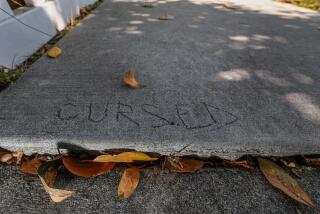Bicyclists, pedestrians wary of Glendale-Hyperion Bridge redesign
- Share via
Mark Marren has watched three people struck by passing cars near a busy bridge that connects the Los Angeles neighborhoods of Atwater Village and Silver Lake.
The most harrowing, he said, was in 2007, when he and a friend left work together on their bicycles. As they pedaled across the Glendale-Hyperion Bridge, a car struck Marren’s friend, hospitalizing him for six months.
“I’ve gone to County [USC Medical Center] and seen my friends laying there because of that bridge,” Marren said at a public forum recently. “I don’t want to see that again.”
The bridge is now at the center of a controversy between engineers and community members, who say a proposed seismic retrofit will make it easier only for cars to speed across and endanger residents who want to walk or bike between the neighborhoods. The design has sparked another iteration in the age-old Los Angeles debate: how and when drivers should share the road.
Engineers say the retrofit — which calls for wider roads, a realigned 5 Freeway offramp and a concrete crash barrier — would move rush-hour traffic more efficiently on one of three links between Atwater and Silver Lake. Advocates say those additions would encourage drivers to treat the bridge as a surrogate freeway.
Local politicians, including Mayor Eric Garcetti and Councilman Mitch O’Farrell, have given their support for some design changes. The city has also submitted an application to extend the deadline for using federal funds, said interim city engineer Deborah Weintraub.
The old structure is a tangle of spans that arch over Riverside Drive, the 5 Freeway and the Los Angeles River. On some portions of the bridge, sidewalks are only a foot wide. There are few crosswalks and no bicycle lanes.
“It feels like something out of Star Trek,” said Deborah Murphy, the executive director of pedestrian advocacy group Los Angeles Walks. “Beam me up and beam me down on the other side, because there is no other way to get across.”
The retrofit calls for one sidewalk for both directions. A portion of the project would also add a pedestrian-only bridge, O’Farrell said, connecting to other pedestrian routes in the area.
The design also calls for a bicycle lane on the shoulder of Glendale Boulevard. Advocates say that isn’t good enough.
“Why are we designing this bridge for the dinosaur, fossil-fuel past, when the future is multi-modal?” said Don Ward, who leads the guerrilla bicycle group Wolfpack Hustle, at a recent public meeting.
O’Farrell said he hopes the needs of pedestrians and cyclists can be met without losing a lane of traffic. Congestion is bad enough during rush hour, he said, that losing a lane could create bottlenecks on the bridge.
“As much as we love to think that everyone will get on their bikes or walk places, the vast majority of people will still be driving,” O’Farrell said. “I don’t want to force people out of their cars if there isn’t an infrastructure there to catch them.”
Weintraub said that to address speed concerns, the Bureau of Engineering is considering posting radar signs to show drivers how fast they’re going, or narrowing the lanes of traffic, a design change that typically forces drivers to go slower.
“I know for a fact that cars speed because I’ve seen it,” O’Farrell, who lives in Glassell Park, told The Times. “You have to focus on slowing cars down, as opposed to the opposite.”
The city has formed a neighborhood advisory group to address the concerns of cyclists, pedestrians and community members. O’Farrell and Weintraub say they hope the modified plans will be finalized by the spring. Construction on the bridge is set to begin in 2016.
More to Read
Sign up for Essential California
The most important California stories and recommendations in your inbox every morning.
You may occasionally receive promotional content from the Los Angeles Times.











